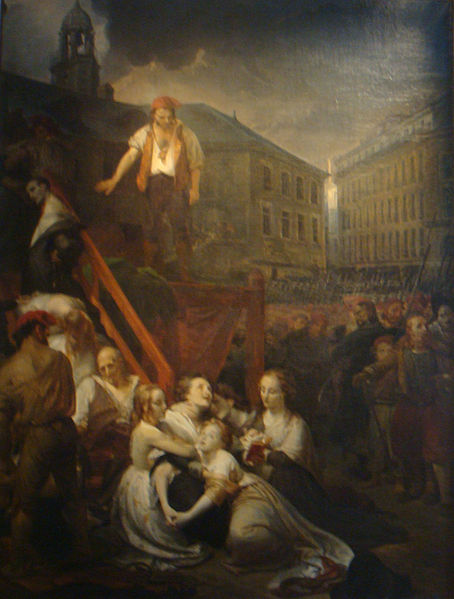Another execution [in Nantes] also tended to change the tide of popular feeling—that of four sisters, the Demoiselles Mello de la Metairie. Deprived of both their parents, these young ladies had continued to live in their native city, devoting their lives to the care of the sick and the consolation of the poor and afflicted. No other crime was ever laid to their charge; but it was enough to draw down upon their heads the fury of the “patriots.” They were denounced as exercising a baneful influence over their countrymen, dragged before the revolutionary tribunal, and condemned to be guillotined on the morrow. The eldest was only twenty-four years of age.
Sainte Croix church, which was used as a prison during the French Revolution.
They were immediately taken to the dungeon of the Clock Tower, which was then used as the condemned cell; there all were imprisoned who had only a few hours to live. The place was selected with a refinement of cruelty. Lying under the huge pendulum, the victims could count, not only the hours, but the moments which remained to them. They felt their life ebbing drop by drop, and saw themselves pushed, second by second, by the hand of time, into eternity. When the innocent girls heard the door close upon them in their living tomb, they knew that they were shut up from all hope on earth—they were beyond all human aid; yet no groan of despair burst from them. They fell upon their knees and prayed to Him for whose consolation no dungeon could be too deep; and they prayed also their mother, who had gone before them into heaven, to obtain for them grace to make a happy death. They, so young, so beautiful, for whom so many days seemed to be in store!
In prayers and tears and mutual embraces the hours passed on, the night fled, and day dawned; at length the moment of execution arrived. Steps were heard on the staircase leading to the dungeon; the door creaked on its hinges; and they flung themselves again upon the ground and invoked the God of martyrs. Then rising, they embraced each other, and in a firm voice said to the jailer, “We are ready.”
A crowd had been assembled in the place for several hours; and when the four young girls appeared, a murmur of pity was heard on all sides; but this feeling was soon repressed, and cries were heard of “Down with the aristocrats! The aristocrats to the guillotine!” These cries, at first raised by a few, were taken up by the whole multitude, for each feared to be suspected of sympathy with the unhappy victims. The executioner could with difficulty force a way through the crowd, but at length arrived at the guillotine. The eldest of the four mounted first, pointing towards heaven as she embraced her young sisters for the last time. In a few moments she was there. The second and the third followed her with the same assurance.
The square where the executions took place, La Bouffay.
Only the youngest remained. Her last moment had arrived. She rose from the earth, and then mounted in her turn the bloody way. The executioner, in order to bind her eyes, took her hands, as she held them over her face that she might not see the mutilated bodies of her sisters. Then the maiden appeared in all the beauty of her youth. She was but fifteen years old; and as she cast her eyes towards heaven, with a divine enthusiasm in her countenance, she looked like an angel ready to fly away from the abode of crime. Even the executioner felt a sensation of pity; and turning towards the people he exclaimed, “She is too young, she is not yet fifteen!”
“Mercy! Mercy!” they cried from every quarter. “The Republic pardons her—she is not yet old enough to die!”
From the scaffold the young girl said to the crowd, “I am more than fifteen. You have killed my sisters, and I am as guilty as they were!”
“No, no,” replied the multitude; “come down. You are pardoned!”
“I do not want pardon, I want to die,” cried the innocent child. “I see my sisters, they are ascending up to heaven. They are calling me, they are waiting for me. O, have pity, executioner, and let me die. I am guilty—just as guilty as they were. I hate the Republic—I detest it! Vive le Roi! Vive le Roi!”
The Executions of the sisters of La Métairie, at Nantes in 1793. Painted by Auguste-Hyacinthe Debay.
“Ah, well, let her die, then,” said a few voices. “Let her die, then,” said the crowd.
The executioner, with a sigh, seized his victim; and soon the angel had rejoined the angels. The man of blood, whose very calling was murder, and who with the utmost indifference had put so many innocents to death, could never efface from his mind the death of that young girl. The next morning he was absent from his post, and in a few days he died.
George J. Hill, The Story of the War in La Vendée and the Little Chouannerie (New York: D. & J. Sadlier & Co. n.d.), pp. 128-130.




No comments:
Post a Comment